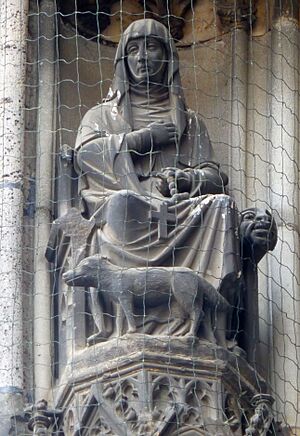Christina von Stommeln facts for kids
Quick facts for kids BlessedChristina von Stommeln |
|
|---|---|

Statue of Christina of Stommeln (northern portal Cologne Cathedral)
|
|
| Religious; Mystic | |
| Born | 24 July 1242 Stommeln, Germany |
| Died | 6 November 1312 (aged 70) Stommeln, Germany |
| Venerated in | Roman Catholic Church |
| Beatified | 8 November 1908, Saint Peter's Basilica, Kingdom of Italy by Pope Pius X |
| Major shrine | Jülich |
| Feast | 6 November |
| Attributes | Religious habit |
Christina of Stommeln (born July 24, 1242 – died November 6, 1312) was a special person known for her deep religious experiences. She was a Roman Catholic mystic, which means she had very personal and spiritual connections with God. She was also called an ecstatic because she sometimes went into trances during her visions. Another unique thing about her was that she was a stigmatic, meaning she showed marks on her body similar to the wounds of Jesus Christ.
Contents
Christina's Early Life and Visions
Christina was born on July 24, 1242. Her parents, Heinrich and Hilla Bruso, were farmers. They lived in a village called Stumbeln, which is now known as Stommeln in Germany.
When Christina was only five years old, she started having religious visions. These were like special dreams or experiences where she felt very close to God. At age ten, she had a dream where Jesus told her she would live with a group called Beguines.
Joining the Beguines
When Christina turned twelve, her parents wanted her to get married. But Christina had other plans. She left home without their permission. She went to Cologne and joined a community of Beguines there.
What were Beguines?
Beguines were groups of religious women in the Middle Ages. They lived together and dedicated their lives to God. They did not take formal vows like nuns, but they lived a simple, spiritual life.
Special Marks on Her Body
At the age of fifteen, Christina began to show unusual marks. These marks appeared on her hands, feet, and head. They were called stigmata.
What are Stigmata?
Stigmata are marks or wounds that appear on a person's body. They are believed to be similar to the wounds Jesus Christ suffered during his crucifixion. For Christina, these marks were part of her deep spiritual experiences.
Because of these marks and her other mystic experiences, some people in the Beguine community did not understand her. They thought she was unwell. This made Christina feel unwelcome. So, in 1267, she decided to return to her home village of Stommeln.
A Special Friendship
When Christina returned to Stommeln, the local priest, Johannes, took her in. While living with him, Christina met a Dominican monk named Peter of Dacia. They became very close friends. Peter was a great support to Christina. He wrote down many of her experiences, which helps us know her story today.
After Peter's death in 1288, Christina's mystic experiences seemed to stop. She then left the priest's home. She moved into a small cloister, which is a quiet religious house. She lived a peaceful life there until she passed away. Christina died at the age of 70 on November 6, 1312.
Her Final Resting Place
Christina was first buried in the churchyard in Stommeln. But her remains have been moved several times over the centuries. In 1342, they were moved to Nideggen. Then, in 1569, they were moved again. Her remains are now in the Propsteikirche (Provost's Church) in Jülich, Germany. There is a special monument to Christina there. Her relics, which are her remains, even survived damage to the church during a war in 1944.
Becoming a Blessed Saint
Christina of Stommeln was officially recognized by the Catholic Church as a "Blessed" person. Pope Pius X beatified her on November 8, 1908. Beatification is a step towards becoming a saint. Her special day, or feast day, is celebrated on November 6, the day she died.
See also
- Saints and levitation

